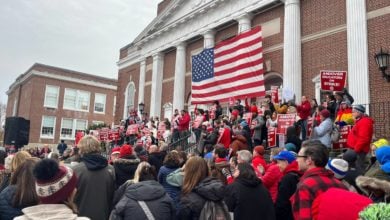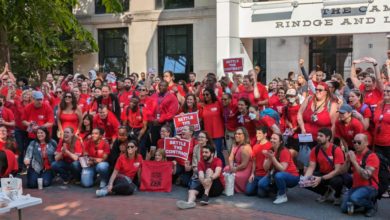Following a 32-day strike, 2,000 workers at a Kohler plant in Wisconsin on December 16 won a new contract that narrows the hated two-tier wage structure and improves health benefits.
The workers’ victory in the Kohler strike has importance far beyond Wisconsin for a number of reasons. Large-scale, open-ended strikes in the manufacturing sector have become less common as corporations have used the threat of plant closure to reduce labor’s bargaining power. In addition, despite a series of anti-union attacks including Scott Walker’s anti-collective bargaining bills, the Kohler strikers show that workers in Wisconsin are still ready to fight.
Workers at Kohler Company in Wisconsin produce bath and kitchen fixtures and are represented by UAW Local 833, a union with a long history of struggle against one of the state’s most anti-union employers. Following union recognition strikes in 1897 and 1934 (during which two strikers were killed by company police), the workers joined the UAW in 1952. Major strikes took place in 1956-64 — the longest strike in US history — and 1983.
All the while the Kohler family held tight control of the company – one of the nation’s largest privately held corporations — and played a major role in state politics. From 1929-31, Walter Kohler Sr. was both company president and Wisconsin governor, while his son, Walter Kohler Jr., also served as governor in the 1950s.
In 2010 the company used the impact of the financial crisis on the construction industry to successfully push the workers into agreeing to a number of concessions including a five-year wage freeze and a two-tier wage system that paid entry level Tier B workers as little as $11.50 an hour, or less than half of what the average Tier A worker earned for the same work.
At the time, the company has over $6 billion in revenue and had swelled in size due to acquisitions of 48 competitors since 1982 as well as expanding operations into the tourism industry by launching golf resorts in Wisconsin and Scotland.
Two-tier wage and benefit plans give employers multiple ways to attack workers. As the higher tier workers retire, the overall wage costs go down, while the company has a tool to pit one set of workers against another. Fights against two tier wage and pension plans continue to take place across the country, including in the auto industry, where recent UAW contracts made major gains in reversing a two-tier system.
Following the five-year wage freeze and amid Kohler’s continued financial success, getting rid of the hated two-tier wages was a priority for the workers in the 2015 negotiations. Instead, the company offered no changes in the two-tier system and 2 percent raises on top of increased health care costs. Moreover, Kohler CEO David Kohler said that if the two-tier wage system disappeared, so too would the jobs from Wisconsin.
In November 94 percent of the workers voted to strike and set up 24-hour picket lines, often in cold and snow. The picket line held strong with community and other unions supporting the strikers. The picket line reached over 1,000 people and donations of food and other necessities poured in, including wood to burn in barrels to keep the strikers warm.
Against the company’s attempts to split Kohler workers, Tier A workers spoke out in support of their fellow workers. “Aren’t young people who work alongside me supposed to be treated the same, aren’t we supposed to be equal?” Louis Wery, a top-tier who earns more than $25 an hour, told the Guardian.
Another top-tier worker with 24 years of experience, Bob Durfee told Al-Jazeera, “We’re all one, all united. We should all have the same pay, pretty much across the board.”
After 32 days on the picket lines, on December 16 the union reached an agreement on a contract that significantly closes but does not eliminate the gap between the two tiers. Minimum pay for the vast majority of Tier B workers will rise from $11.50 to $15 an hour and some will earn $19-21 an hour.
This translates to an average increase for Tier B workers of 37% over four years. Tier A workers will see 2% raises each year and will also receive a $2,000 bonus. Overall, the strike won $7 million more in wages and benefits for the workers. The union also fought off attempts to dramatically increase health benefit costs.
While the continuing gap between the tiers indicates there is still progress to be made in achieving equity between all workers, the strike made major gains that will allow all workers to have a living wage. Before the strike, some Tier B workers were forced to live in their cars due to the low wages.
While the struggle goes on at Kohler and across the nation for fair and equitable pay, the example of the Kohler workers provides an example of standing together and fighting back against capitalist austerity and corporate attempts to divide and conquer.





